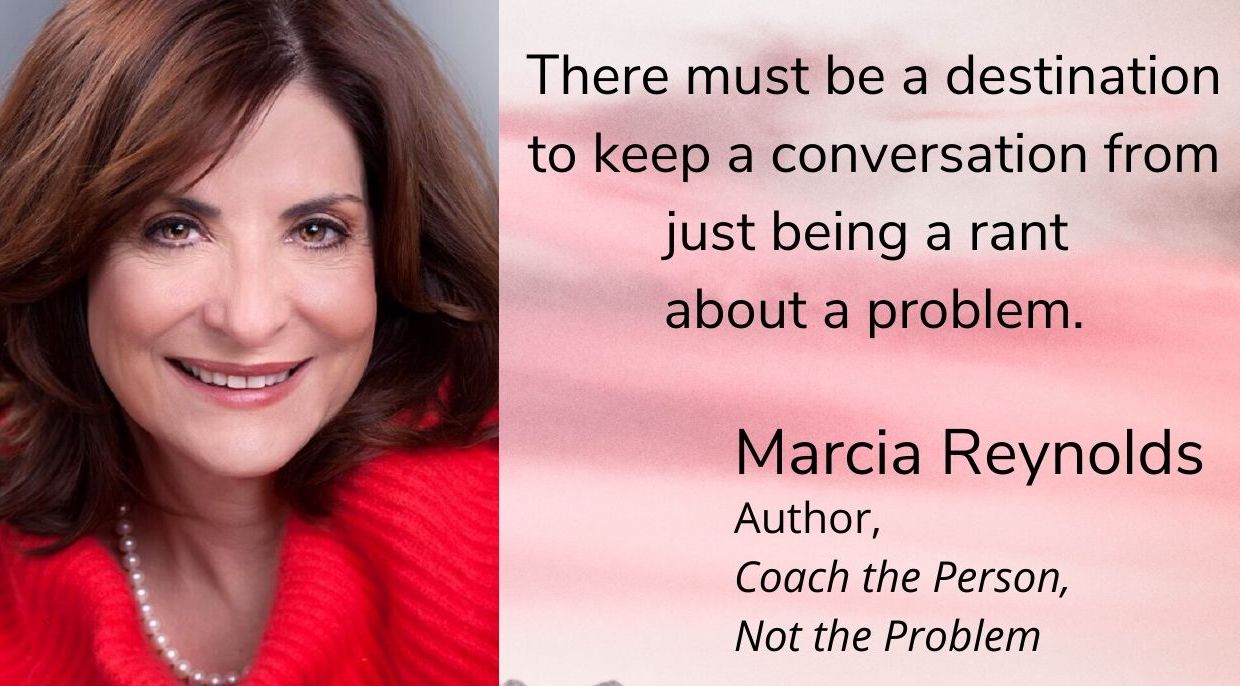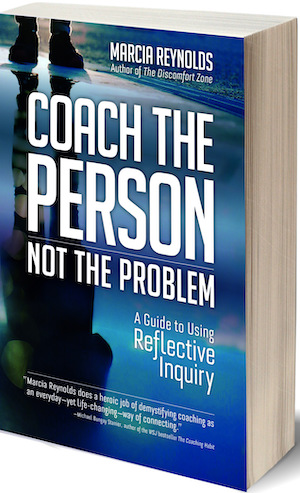
Guest Post by Marcia Reynolds
Radical change and uncertainty make it hard for people to see through the fog to determine what they want. When daily adjustments affect lives and erratic predictions make goal setting impossible, defining a direction seems illogical. Views are further muddled by anxiety and weariness.
Emotions shape our reality more than facts and trend charts.
The less we know for sure, the more we imagine the worse and believe it exists.
A sounding board is a good place to start.
What is the best way of coaching others that will help them navigate the uncertainty of the changing horizon? Give them space to tell the story they see that is defining their current situation. When you let people ramble about the difficulties they are facing, you will hear key statements describing what they need to feel comfortable in the space they are living in right now.
You might hear their exaggerations. They may focus on theories that are unsubstantiated and intended to spread fear. But you can’t just tell people to focus on the bright side and expect compliance. They need to feel heard first.
Then slide the conversation toward an outcome.
Once their story is laid out on the table, use reflective statements such as summarizing and noticing emotionally charged statements, and then ask clarifying questions to unwrap what the person wants instead of what they have now. Play back their story while asking questions such as, “What is most important to you right now? “What are you thinking that you must let go of?” and “What do you know is true about the changes you are describing?”
Help them narrow in on what they need from the conversation. Do they want you to help them see what possibilities they may pursue in the future, or for now, do they need peace of mind with not knowing how the future will unfold? They may need you to help them find ways to stay positive so they can see the opportunities that are emerging now.
If they want to explore a particular opportunity in the future, ask if they have a picture of what this future might look like if they removed the fears and confusion clouding their view.
Your job is to help them name what they want. Once their real desires are articulated, the actions they must take are easier to declare and commit to. Even if they can’t see the future, defining what they need right now ensures progress is made by the time the conversation ends.
Remember to listen with no attachment to the outcome. Just listening and playing back what you hear them say will help them sort out facts from fears.
4 Practices To Coach People in Difficult Times
Follow these four steps to have a conversation that will help people move forward even when the future is unclear:
- Listen to their story. Be patient. Release your judgment. Accept their perspective as how they see the world right now. They need to feel heard and valued before they will examine their thoughts with you.
- Play back what you hear and notice. Summarize what they say, share moments you noticed their emotions were triggered, and play back phrases they repeated and key concepts they stressed. Clarify their beliefs about the present situation and assumptions about the future.
- Determine what they want now. Once they confirm the story, ask them what they want right now instead of what is occurring. They may not know exactly, but at least they may start to see a destination they can move toward. Eventually, there will see something that is in their control to change.
- Create goals from insights. When a new idea or “aha” flash shows up, ask them to articulate what they are learning, seeing, or beginning to understand. Once they identify a new idea, ask what they might do now. Even if they say they need to think about it, get them to commit to reflection time. Declaring a next step ensures movement.
Clear and desired outcomes are the conduit between uncertainty and progress… and are essential if you want to coach people in difficult times.
Note from Jesse: I am delighted to host this guest post by my friend Marcia Reynolds, author of the excellent new book Coach the Person, Not the Problem, a guide for new and experienced coaches. I believe it is also a very useful book for managers and people who support them as it shows how to use the technique of reflective inquiry to resolve problems and determine the right course of action. The book clarifies some difficult to understand concepts in a way that is straight forward, easy to understand and actionable.
 Ideas in this post are taken from Coach the Person, Not the Problem: A Guide to Using Reflective Inquiry by Marcia Reynolds, PsyD, MCC.
Ideas in this post are taken from Coach the Person, Not the Problem: A Guide to Using Reflective Inquiry by Marcia Reynolds, PsyD, MCC.
Marcia is a pioneer in the coaching movement, a past global president of the International Coach Federation and teaches for coaching schools and universities in 5 countries. The book is a culmination of what she has discovered is either missing in coach training or what shouldn’t be so difficult for coaches to master. It offers 5 essential practices and 3 mental habits with tips, tools, and case studies to elevate your coaching conversations. You can find more information on Marcia’s experience, her programs, and her other books – Outsmart Your Brain, The Discomfort Zone and Wander Woman – at Covisioning.com













Jesse
Thank you for creating space for this insightful post
Marcia
You are truly masterful and convey so much wisdom in so few words
“Clear and desired outcomes are the conduit between uncertainty and progress”
To me, that one sentence captures the incredible power of coaching,
Thank you for shining light on the four practices.
Kind regards,
Sridhar
So glad you appreciated Marcia’s guest post, Sridhar!
I thought this was an interesting perspective. I might consider adding an element of time into the process. The framework here implies a fairly quick transition from sounding board to transitioning to find an outcome. Is that the right approach for someone facing a difficult time? Is it okay to stay in sounding board mode for multiple conversations over a more extended period of time?
You raise a good point, Ross. Thank you for adding to the conversation!